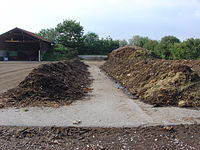
Photo from wikipedia
The main challenge of this work is to identify a novel approach to reuse and valorize brewers’ spent grain (BSG) to produce a new source of income for the brewers… Click to show full abstract
The main challenge of this work is to identify a novel approach to reuse and valorize brewers’ spent grain (BSG) to produce a new source of income for the brewers in terms of self-consumption or selling goods. Therefore, this study explored the composting behavior of BSG mixed with different organic materials: wheat straw with pig slurry solid fraction and wheat straw with sheep manure, MIX1 and MIX2, respectively. The composting process was carried out in bins by comparing two different composting strategies: manual turning (MT) and static composting xxx– without turning operations (ST). During the experimental trial, BSG mixtures were chemically analyzed for pH, total Kjeldahl nitrogen, ammoniacal nitrogen, nitrate-nitrogen, total organic carbon, volatile solids, carbon to nitrogen ratio, and moisture content. Furthermore, the final composted materials were evaluated according to the physicochemical and biological limits fixed by the European regulation (2019/1009) and the Italian law (D.Lgs 75/2010). At the end of the composting process, the C/N ratio ranged from 11.6 to 15.5, the humification ratio ranged from 12.4 to 13.8 and the NH4+-N/NO3−-N ratio was lower than 0.5 indicating, in all investigated treatments, a good degree of maturation. However, as evidenced by the high pH values and low Germination Index, the sheep manure, as starting material, proved less effective than the solid fraction of pig slurry, probably due to excessive trampling and slow litter change. Finally, concerning the two composting strategies investigated, the obtained results highlighted that the composting strategy did not affect the final compost quality.
Journal Title: Agronomy
Year Published: 2021
Link to full text (if available)
Share on Social Media: Sign Up to like & get
recommendations!